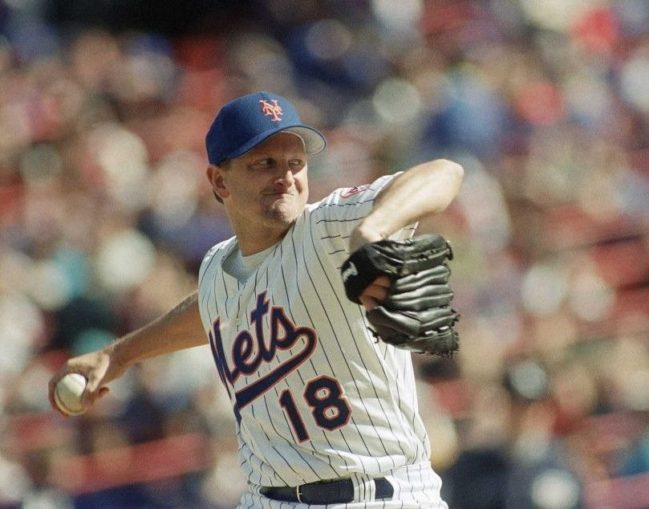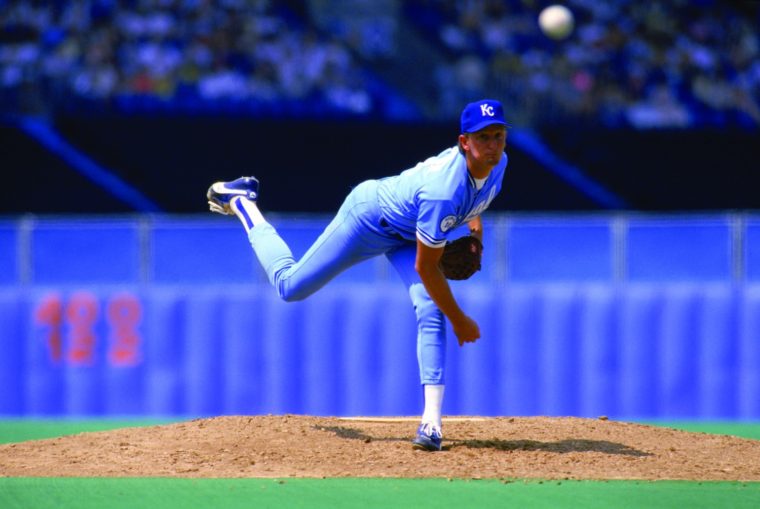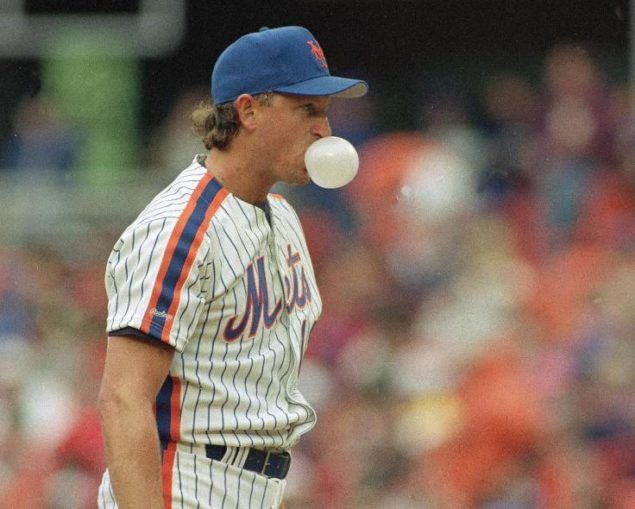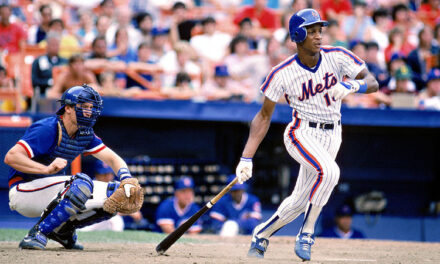
The Kansas City Royals found themselves in familiar territory heading into Game 3 of the 1985 Fall Classic against the St. Louis Cardinals.
Just as they were in the ALCS against the Toronto Blue Jays, the Royals dug themselves into a precarious hole, down two games to none.
Fortunately for the Royals, Major League Baseball had expanded the Championship Series in both rounds starting in the ’85 season, from a best-of-five to a best-of-seven format.
That proved pivotal for Kansas City, as they would win Game 3 before dropping Game 4 at home against the Blue Jays. They stormed back to win three straight, including the last two on the road to clinch the pennant for the second time in franchise history.
When the Royals faced a two games to none deficit against the Cardinals in the World Series, a case of deja vu set in for the club. Fighting back in the A.LCS helped ease their minds in thinking that the Series was a forgone conclusion.
Especially with 20 game-winner and the eventual Cy Young Award recipient on the mound for Game 3.
Bret Saberhagen, 54, was 21-years-old in his second season with the Royals. Drafted in the 19th round of the 1982 MLB Draft, Saberhagen saw his draft stock fall due to shoulder tendinitis which reduced his velocity in his senior year of high school.
Looking to prove scouts wrong, the right-hander spent just 27 games in the minor leagues in 1983 before making the club out of spring training in 1984.
The ’85 season put the young Saberhagen on the map, leading the American League in FIP (2.89), bWAR for pitchers (7.2), WHIP (1.058), and Win Probability Added (5.0). The control artist had only one game in which he walked three batters, otherwise, he allowed no more than two walks in 31 of his 32 starts that season.
Toeing the rubber for a crucial Game 3 start in the World Series, Saberhagen cited the Championship Series as reason why the Royals felt like it was far from over.
“That was kind of fresh in our minds,” Saberhagen said. “I don’t think any of us really felt that we were on the brink of getting eliminated and losing that.”
The Royals took Game 3 by a score of 6-1, behind a complete game, one-run performance from their young ace. He became just the seventh player under the age of 22 to win a World Series game with a complete-game effort.
The amazing thing was, his best start was yet to come.
With the Royals and Cardinals knotted up at three games apiece, Kansas City tasked Saberhagen with the decisive Game 7 against the Cardinals’ ace, John Tudor. Saberhagen delivered a masterful performance, scattering five singles and not allowing a single walk in his second complete game of the Series in the Royals’ 11-0 title victory.
Saberhagen became just the ninth pitcher in World Series history to toss a shutout in a Game 7, and the first since Sandy Koufax in the 1965 Fall Classic. For his two masterful performances, Saberhagen was named the MVP of the Series.
After reaching the pinnacle of the baseball world in just his second year in the league, Saberhagen’s ensuing seasons featured a mix of dominance and underperformance, with health and injuries being a main culprit for his struggles.
In December of 1991, two years removed from winning his second AL Cy Young Award, Saberhagen was dealt to the Mets along with infielder Bill Pecota for Gregg Jefferies, Kevin McReynolds and Keith Miller. A mixture of confusion and surprise occurred for Saberhagen, who was given assurances that he was not going to be traded just days earlier by the Royals general manager, Herk Robinson.
Saberhagen spent parts of four seasons with the Mets (1992-95), compiling a 29-21 record with a 3.16 ERA and a 1.079 WHIP over 76 games (74 starts). Those Met teams underperformed during Saberhagen’s tenure, with injuries and ineffectiveness impairing the team.
One feat that Saberhagen remembers fondly was in the strike-shortened season in 1994, when he had more wins (14) than walks (13). He finished third in the NL Cy Young voting that season and made his third and final All-Star team.
Overall for his career, Saberhagen compiled a 167-117 record over 399 games (371 starts), with an ERA+ of 126, and a 58.8 bWAR over 16 seasons in the majors.
I had the privilege of speaking with Saberhagen in early June, where we discussed the ’82 Draft, his sensational ’85 season which resulted in the Royals’ first World Series Championship and his thoughts on his tenure with the Mets.

MMO: Who were some of your favorite players growing up?
Saberhagen: Being born in Chicago, I was a big fan of the Cubs. My first big league game I went to was at Wrigley Field. My favorite player was probably Jose Cardenal, I just loved his persona and how he came on and off the field with his little kind of stride. When he would go up to hit he would fold his cap in half and put it in his back pocket and get after it. I loved him.
All of those Cubs: Burt Hooton, Fergie Jenkins and Billy Williams. I loved when Billy would get up there and take his practice swings and I can’t remember if he used to spit and swing at it or if he used to throw his gum out and take a hack? I think he spit and took a practice swing.
I got a chance to meet Don Kessinger back when my son was playing in the SEC, so that was pretty cool. I think his grandson was playing for Ole Miss and I got a chance to meet him there. That was kind of cool getting to meet one of your favorite shortstops growing up.
It was more of the team than necessarily a player, but the late ‘60s early ‘70s Cubs [were my favorites].
MMO: Who introduced you to the game at a young age?
Saberhagen: My grandfather. He used to coach American Legion Baseball and he used to get me out there and mess around with the ball and have a good time.
MMO: What positions did you play growing up other than pitcher?
Saberhagen: I primarily was a shortstop and a pitcher.
MMO: It’s always fun to look back and think of what could’ve been, but do you think you could’ve made it to the majors as a shortstop?
Saberhagen: I never say never but it would’ve been a little bit longer ride to get to the big leagues.
I tell a lot of people if you have a decision to make between two positions, first off, go with the one you really, really love. If pitching is one of them just remember that there are 11 pitchers and sometimes more on a staff and usually only one or two [backup] infielders unless you can play multiple positions and three outfielders. So you have to take that stuff into consideration.
MMO: What were your memories leading up to the 1982 MLB Draft?
Saberhagen: When the Draft comes around it doesn’t bring very happy moments for me. I was drafted in the 19th-round by the Royals and I had some arm problems coming out of my senior year in high school.
I came from basketball into baseball and trying to impress the scouts. I ended up having some tendinitis in my arm, so when I came back to throw my speed dropped tremendously and the scouts saw how I was throwing.
They all kind of vanished except for Guy Hansen with the Royals, he stuck around and continued to see me improve.
By the time the Draft came around, we hadn’t gone through playoffs yet, and I was told that the latest I probably would’ve been picked was the seventh-round. So I had no idea and finally, I got a telegram in the mail saying I was drafted by the Royals in the 19th-round.
So yeah, it was a little ego damage done. The bottom line is, for me, when someone said I couldn’t do something or push me to a test I tried to prove them wrong.
It worked out alright, I was drafted with the right team. They needed some pitching and a year after being in the minor leagues you’re in the big leagues so it worked out alright.
MMO: You mentioned spending just one year in the minors, as you pitched just 27 games before making the Royals’ Opening Day roster in ’84 at 20-years-old. What were your thoughts on spending just one year in the minors and being such a young player on a Royals team that had made it to the postseason five of the last eight years?
Saberhagen: They had a very good team as it was, that’s for sure. Stepping into a good quality group of guys and going into spring training as a non-roster player, I was hoping to make the Triple-A squad.
I had very good spring training, I think there were a couple of guys that were very happy with me, Dick Howser being one of them. He brought Mark Gubicza and me in and I was hoping that he was going to say that I was going to the big league club but worst case scenario I was hoping he would tell me I was going to Triple-A.
When he said I was going to go north with the team and going to be used in the bullpen I was kind of blown away. I was very excited and it was awesome, it was pretty cool.
MMO: You had a phenomenal sophomore season in 1985 in which you posted a record of 20-6 with a 2.87 ERA, leading the league in FIP (2.89), WHIP (1.058), and winning the AL Cy Young Award. When you look back on that season, what memories stand out the most for you?
Saberhagen: You know, I don’t remember game-to-game or pitch-to-pitch; some people have that gift where they can recall tons of things. I’m more of if you remind me of something I’ll say, ‘Oh yeah, that’s right.’
In 1985, we were coming down to the end of the year and if I’m not mistaken I don’t think our starters missed one start that year. I think as a group collectively we made each and every call going out there. So we stayed healthy which was key and we were battling with the Angels. There was a big series in Kansas City and we took three out of four which really got us going.
Back then there wasn’t a Wild Card, there were only two teams from the American League and two teams from the National League that went to the postseason. So it was a little tougher to get to the postseason as I found out after my second year in 1985 and not going back to the postseason for many years. It’s a little tougher than you think.
MMO: Being down 2-0 against the St. Louis Cardinals in the World Series, what was your mindset like for that Game 3 start?
Saberhagen: I kind of fed off of the veteran guys. I think the good thing about that particular Series is we had just went through the same thing with Toronto. We were down 2-0 and then 3-1 and came back to win the last three to get to the World Series. That was kind of fresh in our minds so I don’t think any of us really felt that we were on the brink of getting eliminated and losing that.
I think it all kicked in for me in Game 7. That was probably the most stressful feeling that I ever had because you know if you go out there and win you’re World Champions. You celebrate something very special with a fun group of guys that are family. The city and fans, everyone’s excited and so I had a lot of weight on my shoulders going into Game Seven. That was a little more stressful than Game Three.

MMO: You became just the ninth pitcher to toss a shutout in a Game 7 of the World Series, and first since Sandy Koufax in 1965. You pitched to contact that night, as you struck out just two batters but limited their offense to just five singles. What memories stand out from that night?
Saberhagen: I was never really a big strikeout guy. I wouldn’t be considered a fly ball pitcher or groundball pitcher; I would kind of get them when I needed certain parts of the plate.
Certain hitters, you kind of know what they might do with the ball. If you need a pop up I usually come up and in to get the pop up. Groundball you’re throwing down and away or down and in trying to get them to roll over on it. Nowadays, I might be a strikeout pitcher with as many guys striking out as much as they are but I just hated walking guys.
In that big ballpark in Kansas City, it’s late in the year, so the ball is not carrying all that well. I just pitched to contact, let them hit it and we had an unbelievable defense. We were so solid up the middle and I think our team and St. Louis’s team were built the same way; we were defense strong, both teams had some speed, and we both had good pitching staffs.
MMO: I’m curious to hear your thoughts on today’s pitchers, with the live arms and high strikeout totals, do you think there should be a more concerted effort to teach pitching to contact more?
Saberhagen: I’m not a big fan of the way the game is played current day. A lot of teams are going to the bullpen so early, and again, I know there are a lot of great arms in the bullpen nowadays. A lot more so now than there was when we were coming up and when I was playing in the eighties.
The game’s kind of changed and the Royals showed it to you in 2014-15 when they had a seventh-inning guy, eighth-inning guy and ninth-inning guy. And all three of them have been and are good quality closers.
The game’s changed but I don’t think for the better in that aspect. You don’t have guys grinding it out, they’re happy with going five or six innings. Every once in a while I get together with some veteran pitchers such as Roger Clemens, John Smoltz, Tom Glavine, or Greg Maddux and we just shake our heads and go, “If someone came to the mound in the sixth inning, and I had 80 pitches and they were taking me out, you’d tell them to go get the f*** off our mound! This is my game, I got this.”
Don’t be looking at some guy from MIT that’s telling you that he’s had so many pitches and this is what he’s doing in this particular situation. This is a sport, and again, there are tendencies that come into play that are helpful. But I think they’re going to the extreme where it’s becoming a computer-type of game now and they’re pushing the buttons rather than going out and playing it and taking a look at what that pitcher’s doing on a particular day.
MMO: What were your initial reactions when you heard you were traded to the Mets after the 1991 season?
Saberhagen: I was surprised because four days ahead of that there were rumors floating around. Herk Robinson — the GM at the time — said, “Bret Saberhagen is not going to be traded. So you can put those rumors to rest.” And four days later I find out that I’m being traded to the Mets, so don’t always believe what you hear. [Laughs.]
At times you hear from a general manager and I found out after we got Mark Davis, the closer from San Diego after his Cy Young year. I believe we both won Cy Young Awards that year; he was in the NL and I was in the AL in ’89. He came over after the ’89 season to us.
I signed an extension on my contract with [John] Schuerholz and he said, “Bret, this is all we have to give to you. If you take it, great! If you don’t, we can figure something out for maybe next year or the following year.” I was completely happy being in Kansas City so I took the deal, the three-year extension.
Sure enough, they sign Mark Davis shortly after for a little bit more money and for the same length of contract. I shook my head and went, ‘You know what? You SOB!’ But I was very happy because we got a great closer who was happy to come over and help us out.
And the way I looked at it was, that was the amount of money he had to spend on me to get another player in. Yeah, he had a little bit more money, but again, I was looking for security and to stay in Kansas City because I was very happy there.
I found out that this became a business, that’s my story behind this, that this is a business. When I got traded to the Mets I just kind of realized that this was a business and you’ve got to pick up and move on.
When I was traded from the Mets, it was during the season and they had held up the bus and the plane because they were working on a deal. Rumor was that I was possibly involved but when I got called in I didn’t think I was going anywhere. That was a tough one, I had some tears come out that night because [it was] just unfinished business there, so to speak. We had a great team but we just never, ever put it together.
John Franco is a dear close friend and I made a bunch of close friends on that team, it was very tough. I showed up in Colorado and Larry Walker told me, “When we found out we got you on the team, our flight was rocking and rolling 37,000 feet up above!” They were extremely happy to have me come over.
MMO: Obviously, the years you were on the Mets were tough both for the team and you personally with injuries. How difficult was it for you to not live up to certain expectations in New York?
Saberhagen: I always felt that the Midwest was where I should be, I always enjoyed being out there. When I look back on my career, I’m very excited that I had an opportunity to play in a few other places and see what baseball was actually like back east for the Mets and Red Sox. If I never got traded I would never have experienced how they are so passionate about the game. It was just unfortunate to have come up a little short.
The ’94 season was good for me, I ended up with more wins than walks when the strike came about. Unfortunately, that season didn’t finish out because we had a pretty good ball club that was doing pretty well, who knows what the last month and a half would’ve brought.
For the most part, I think there was a lot of excitement for guys like Bobby Bonilla, Eddie Murray, Willie Randolph and myself. We had Jeff Torborg coming over after having success over in Chicago to be the manager. Just a lot of excitement and a lot of good ballplayers. When you have a rotation with David Cone, Dwight Gooden, Bret Saberhagen, Sid Fernandez and John Franco as your closer, you expect to win games.
We had some injuries, some guys with off years, and again, you can have one or two guys have really good years but it takes a full squad, a full team to win championships. We did a lot of stuff together and we were a good bunch of guys that all liked to hang out and do things together but we just never put it together on the field, unfortunately.

MMO: What would you say the best thing about playing in New York was for you?
Saberhagen: I grew up when I went to New York. You’ve got to be responsible for what happens playing-wise and I found out in New York if you have a bad game you need to own up to it. Fans appreciate that a lot more, especially the East Coast fans, the knowledgeable fans.
You can’t make excuses for anything you do out there, so I think the best thing that happened to me in New York is I grew up as a person and as a player.
MMO: Who was the toughest hitter you faced in your career? Conversely, who did you have great success against?
Saberhagen: It was funny because I was on “The Rich Eisen Show” recently in Kansas City, and he asked me the same question. I said Wade Boggs and I gave him a story. There was one game where he got a base hit in his first at-bat on a fastball. His second at-bat a base hit on a curveball. Third at-bat was a base hit on a changeup, and those were the three pitches I threw! I was like, ‘I don’t have anything else to throw ya!’
As we continued to talk a little bit [Eisen’s] guys ran the numbers on what I did against Boggs, and he hit .450 off me. And he was a .330 lifetime hitter so I definitely helped him out with that! [Laughs.]
I forget the exact numbers but I got him out 33 times, so whatever the numbers happened to be it was funny because one of the guys said, “You should’ve said at least I got him out 33 times!” I faced him a lot and he wore me out.
The other guy was Reggie Jackson, I caught him at the end of his career. I think I went through the first three or four seasons and he didn’t get a hit off me. I think the last year that I faced him he got two hits off of me; I think he ended up getting a double and a home run. So he was 2-for-31 against me, but again, I caught Reggie, not in his prime.
Those are the two guys I remember having success against and not so much success against, although I did get Boggs out 33 times. [Laughs.]
MMO: Since you retired from the game, what has Bret Saberhagen been up to?
Saberhagen: My foundation, the Bret Saberhagen Make A Difference Foundation, has been around for a while. I haven’t done any big events since the economy went kind of south in 2008, which I haven’t gotten back into yet. I don’t have anyone on my staff so it’s pretty much just me getting everything set and done.
I still bring in some money each year through things that I do whether it be some autograph signings or celebrity bartending where all the tips go into my foundation.
I’ve done a few things to raise money and I give the money to the kids; it’s always geared towards youth. It seems like lately, I’ve been finding myself doing tons of different events for children’s hospitals. I just came out of Kansas City where the Big Slick event raised over $2 million for Children’s Mercy Hospital. I do stuff every year for Akron’s Children’s Hospital back in Akron, Ohio, I’ve been doing stuff for them over the last dozen years or so.
I’ve been doing some stuff for the Florida Children’s Hospital and Robbie Gould’s Tournament is coming up, he does it for Chicago’s Children’s Hospital.
I also do some golf events and I enjoy golf and boating during the summertime. During the winter I do some snow skiing, I love getting to the slopes. And then some personal travel and appearances so I’m still out there doing a few things in and around for different companies. Seems like my schedule is filled from Jan. 1 to Dec. 31!
MMO: It was great speaking to you today, Bret. Thanks very much for some time today and looking back at your impressive major league career.
Saberhagen: My pleasure. Thanks very much.
Follow Bret Saberhagen on Twitter, @BretSabes















